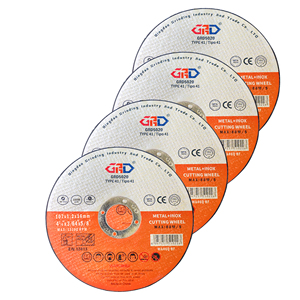
All categories
Featured selections
Trade Assurance
Buyer Central
Help Center
Get the app
Become a supplier

(26079 products available)














































Continuous Rim Discs
A continuous rim disc is ideal for shiny and sleek cutting of brittle materials. As a consequence, concrete, tile, and glass are preferred due to the non-stop rim. The steady rim limits chipping and cracking as it gives a clean-cut surface. These discs are ideal for diamond cutting disc users looking for precision in their cutting tasks.
Segmented Rim Discs
Segmented rims are channeled for aggressive cutting. This type of disc is perfect for cutting hard materials like reinforced concrete and brick. The segments are raised which permits rapid removal of material and thus suits tasks where speed and power are a priority. Nonetheless, segmented discs may not supply as clean a cut as continuous rim discs, so they are mainly used.
Turbo Rim Discs
Turbo rim discs incorporate the traits of continuous and segmented rims. These are preferred for their swiftness in providing a stable cut, especially on hard surfaces. The serration makes it efficient in material removal, while the patterned rim aids in smoother finishing. Such discs serve multipurpose and are suitable for most construction activities.
Diamond Blades with Notches
Notched diamond cutting discs are favored while cutting hard, brittle material. The notches help in the swift removal of material. This property allows cuttings in granite, or hard paving blocks. It's advantageous when controlling chipping on brittle edges. Experts in stonemasonry mostly apply these discs when cutting granite or marble.
Risk Discs
These discs are designed for rough cuts in heavy-duty applications. Their segment shapes and positioning make them ideal for large-scale operations requiring durable performance under harsh conditions. For instance, in heavy construction or mining operations, segmented discs provide the cutting power and longevity needed.
Construction Industry
Diamond discs have grown to be standard in the construction industry. As they provide clean and precise cuts in concrete, brick, and asphalt. Construction workers use them to cut expansion joints, building materials, paved roads, etc. The endurance of discs means they can handle huge tasks with tones, valued in both commercial and residential constructions.
Stone Masonry
In stone masonry, diamond discs are essential for cutting granite, marble, and limestone. Stone masons depend on the precision and smooth finish provided by diamond cutting discs, mainly in countertop fabrication, tombstones, and architectural stonework. Continuous rim and notched rim discs are mostly applied for their power to avoid chipping and cracking.
Metalworking
Diamond cutting discs are being used in metalworking institutions. Mostly when cutting hard materials like stainless steel and ferrous alloys. They hold an advantage over standard abrasive wheels in their longevity and cutting speed. Thus making them ideal for precision tasks in metal fabrication and automotive industries.
Mining Industry
The diamond discs are extensively used for coring and cutting soft and hard rocks in the mining industry. Segmented and turbo discs are named for their durability in extreme conditions. Thus making them suitable for large mining machines. These discs are designed to perform the cutting power required for valuable minerals and resources.
Glass and Ceramics Industry
Diamond cutting discs are preferred to cut glass and ceramics due to their accuracy. With a diamond blade, it ensures a fine and crack-free edge on tiles, windows, and glass-based designs. Ceramic and tile finishing in remodeling and construction comes from continuous rim discs mainly employed by glaziers and tilers.
The diamond cutting discs feature variable specifications depending on the tasks. Discs range in diameter from 115 mm to 350 mm. For segment thickness, it varies from 2.5 mm to 10 mm. The rim of the segments may be turbo, notched, or segmented. Blades are put together by bonded diamond segments to ensure prolonged wear resistance. Blades also include drive holes for mounting systems. Designed with cores to reduce vibrations.
It's not hard to install diamond cutting discs. The user first looses the existing disc from the power tool or machine. Then ensures the diamond disc is well-mounted on the spindle. A safety guard is also encouraged. After mounting, the user equalizes the power tool. Further, adjustment of the machine's speed to the disc's specifications is important before use.
The diamond cutting disc must be at full speed before it contacts the material to be cut. The user must hold the tool with both hands for safety. Appropriate pressure must be applied to allow cutting without forcing the blade. The user keeps' the cutting line straight to avoid disc damage and ensure clean cuts. The should take breaks between cuts on heavy materials to let the disc cool.
Keep diamond cutting discs in good form by properly maintaining and repairing them. It's important to clean a disc after every use. Remove debris with a wire brush or cloth. Inspect the disc weekly for damage or wear. Try checking for cracks or chipped segments. Mounting a burnt or warped disc affects performance. To repair a diamond disc, take it to trained professionals to reshape the segments. The only thing users can do is replace worn-out discs. Users should never attempt to weld broken segments back onto the disc.
A1:Its continuous rim and segmented rim design makes it ideal for cutting hard materials. The continuous rim is ideal for smooth cutting. While the segmented rim is ideal for hard and aggressive cutting.
A2:Construction, masonry, metallurgist, mining, and glass and ceramics industries are the main users of diamond blades. Therefore, diamond blades are versatile and durable to handle cutting tasks in these businesses.
A3:They provide cutting versatility, maximum cutting accuracy, and high durability. Moreover, they feature heat resistance to provide optimal performance.
A4:Cleaning, inspection, and replacement of worn or damaged discs are maintenance and repair considerations. Proper storage is another crucial consideration for maintaining the discs' condition.
A5:It affords cooling for the disc's segments during cutting. Also, it reduces heat buildup. Thus, it enhances the disc's performance and longevity, especially during heavy-duty cutting applications.